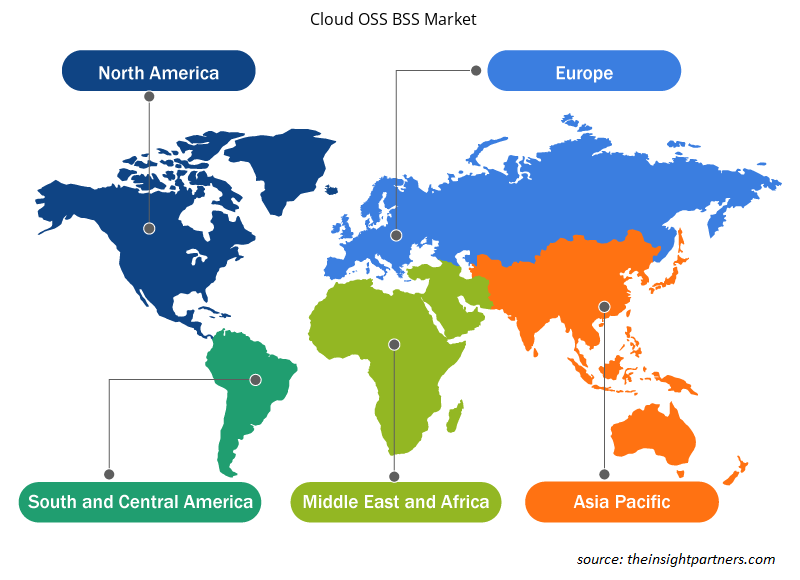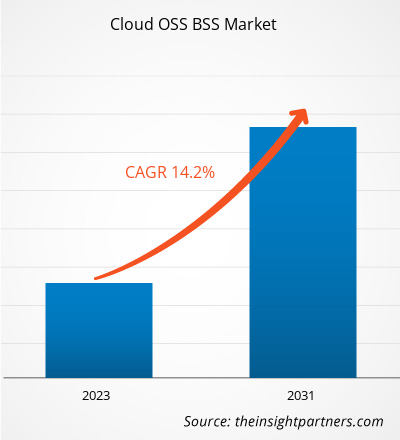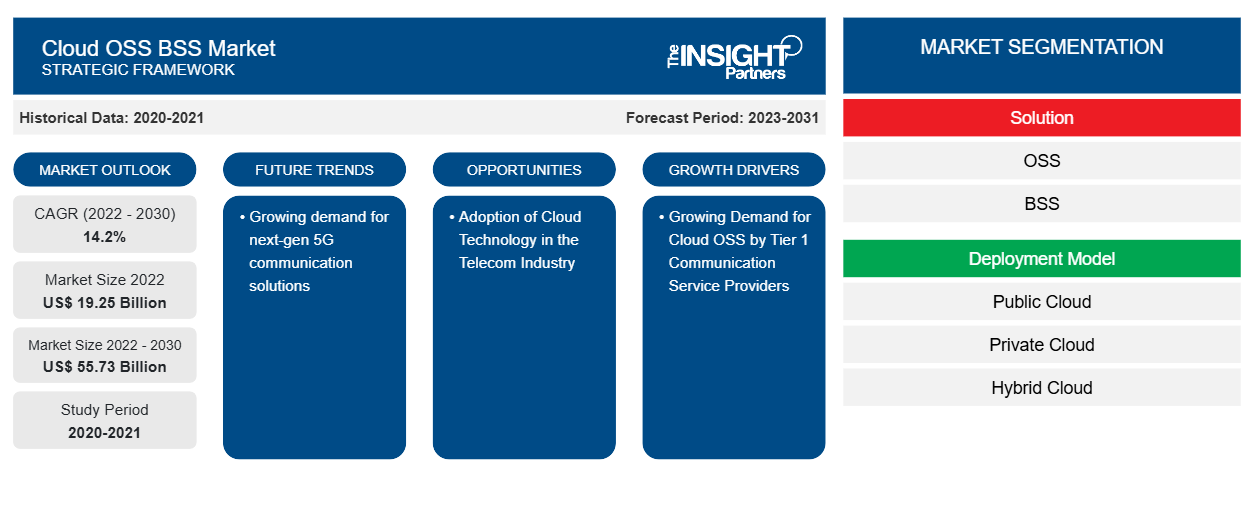Si prevede che la dimensione del mercato cloud OSS BSS raggiungerà i 55,73 miliardi di dollari entro il 2030, rispetto ai 19,25 miliardi di dollari del 2022. Si prevede che il mercato registrerà un CAGR del 14,2% nel periodo 2022-2030. È probabile che la crescente domanda di soluzioni di comunicazione 5G di nuova generazione rimanga una tendenza chiave nel mercato.
Analisi di mercato Cloud OSS BSS
Le aziende di sistemi di supporto operativo cloud (OSS) e sistemi di supporto aziendale (BSS) stanno investendo in modo significativo nello sviluppo di soluzioni nuove e innovative in risposta alla crescente domanda di questi prodotti. I fornitori stanno aggiungendo diverse funzionalità alle loro soluzioni per differenziarsi dai concorrenti. A luglio 2021, Sterlite Technologies Ltd (STL) ha annunciato il suo piano di collaborare con Microsoft per fornire soluzioni OSS/BSS cloud-native ai fornitori di servizi di telecomunicazione. Queste soluzioni aiuterebbero le aziende di telecomunicazioni a creare applicazioni pronte per il futuro tramite la sua piattaforma BSS digitale. Con questa partnership, STL fornirà alle aziende di telecomunicazioni l'accesso a microservizi modulari flessibili, un ecosistema di sviluppo app cloud-native e completo e un sistema di gestione cloud ibrido. Tali innovazioni nelle soluzioni cloud OSS BSS, supportate da elevati investimenti da parte dei fornitori per migliorare i loro portafogli di prodotti per soddisfare le mutevoli esigenze dei clienti, stanno guidando la crescita del mercato cloud OSS BSS
Panoramica del mercato Cloud OSS BSS
I sistemi di supporto operativo e i sistemi di supporto aziendale utilizzano il cloud computing, gli strumenti di automazione e l'analisi per semplificare le operazioni nell'intera organizzazione delle telecomunicazioni , comprese le operazioni e le attività dei clienti. Utilizzando OSS e BSS insieme, le società di telecomunicazioni possono facilmente collegare i clienti a soluzioni tecnologiche affidabili.
Personalizza questo report in base alle tue esigenze
Riceverai la personalizzazione gratuita di qualsiasi report, comprese parti di questo report, o analisi a livello nazionale, pacchetto dati Excel, oltre a usufruire di grandi offerte e sconti per start-up e università
-
Scopri le principali tendenze di mercato in questo rapporto.Questo campione GRATUITO includerà analisi di dati che spaziano dalle tendenze di mercato alle stime e alle previsioni.
Driver e opportunità del mercato Cloud OSS BSS
Crescente domanda di Cloud OSS da parte dei fornitori di servizi di comunicazione di livello 1
Le soluzioni Cloud OSS aiutano il settore delle comunicazioni ad affrontare numerose sfide tecniche e aziendali. Cloud OSS viene utilizzato per molteplici applicazioni grazie alla sua tecnologia eterogenea e al panorama dei fornitori. Queste soluzioni offrono un modo efficiente e semplice per la condivisione delle risorse, l'automazione e il monitoraggio. Utilizzando soluzioni Cloud OSS, i CSP semplificano le procedure di aggiornamento software, riducendo così notevolmente i costi garantendo tempi di inattività prossimi allo zero durante l'aggiornamento. Cloud OSS avvantaggia i CSP di livello 1 offrendo elasticità per gestire scenari di traffico a raffica senza alcun investimento iniziale. La soluzione Cloud OSS fornisce anche un time-to-market più rapido per i nuovi servizi poiché le nuove funzionalità possono essere facilmente aumentate o diminuite su richiesta. Inoltre, le soluzioni Cloud OSS forniscono ai CSP di livello 1 soluzioni Big Data e analisi. Pertanto, il conseguente aumento della domanda di soluzioni Cloud OSS tra questi fornitori di servizi aumenta il mercato Cloud OSS BSS.
Adozione della tecnologia cloud nel settore delle telecomunicazioni
La tecnologia cloud sta avendo un impatto significativo sul settore delle telecomunicazioni in quanto riduce i costi operativi e amministrativi per le società di telecomunicazioni. Migliora inoltre la loro comunicazione e collaborazione con le reti di distribuzione dei contenuti. Inoltre, i provider di servizi cloud aiutano le aziende di telecomunicazioni a concentrarsi sui servizi aziendali essenziali piuttosto che su IT, aggiornamenti del server e problemi di manutenzione. La tecnologia cloud ha aumentato il numero di provider di telecomunicazioni in tutto il mondo. Le piattaforme del modello di distribuzione cloud forniscono servizi IT e di comunicazione su qualsiasi rete , come fissa e mobile, con copertura mondiale. Possono essere utilizzati anche tutti i dispositivi connessi degli utenti finali, come smartphone, PC e televisori. Pertanto, la crescente adozione della tecnologia cloud nel settore delle telecomunicazioni sta creando maggiori opportunità per il mercato.
Analisi della segmentazione del rapporto di mercato Cloud OSS BSS
I segmenti chiave che hanno contribuito alla derivazione dell'analisi di mercato del cloud OSS BSS sono la soluzione, il modello di distribuzione e le dimensioni aziendali.
- In base alla soluzione, il mercato cloud OSS BSS è suddiviso in OSS (gestione e orchestrazione della rete, gestione delle risorse, analisi e garanzia e progettazione e adempimento del servizio) e BSS (gestione della fatturazione e dei ricavi, gestione dei prodotti, gestione dei clienti e altri)]. Il segmento OSS ha detenuto una quota di mercato maggiore nel 2022.
- In base alle dimensioni dell'impresa, il mercato è segmentato in piccole e medie imprese e grandi imprese e in base al settore (informatica e telecomunicazioni, BFSI, media e intrattenimento, sanità e altri).
Analisi della quota di mercato di Cloud OSS BSS per area geografica
L'ambito geografico del rapporto di mercato cloud OSS BSS è suddiviso principalmente in cinque regioni: Nord America, Asia Pacifico, Europa, Medio Oriente e Africa, e Sud e Centro America.
Il Nord America domina il mercato cloud OSS BSS. Gli Stati Uniti detengono più della metà della quota di fatturato regionale in quanto hanno il mercato delle telecomunicazioni più maturo. D'altro canto, la crescente competizione tra i fornitori di servizi di comunicazione per aumentare la base clienti e migliorare l'efficienza operativa fornirebbe opportunità di crescita per il mercato cloud OSS BSS in Canada.
Approfondimenti regionali sul mercato Cloud OSS BSS
Le tendenze regionali e i fattori che influenzano il Cloud OSS BSS Market durante il periodo di previsione sono stati ampiamente spiegati dagli analisti di Insight Partners. Questa sezione discute anche i segmenti e la geografia del Cloud OSS BSS Market in Nord America, Europa, Asia Pacifico, Medio Oriente e Africa e Sud e Centro America.

- Ottieni i dati specifici regionali per il mercato Cloud OSS BSS
Ambito del rapporto di mercato Cloud OSS BSS
| Attributo del report | Dettagli |
|---|---|
| Dimensioni del mercato nel 2022 | 19,25 miliardi di dollari USA |
| Dimensioni del mercato entro il 2030 | 55,73 miliardi di dollari USA |
| CAGR globale (2022-2030) | 14,2% |
| Dati storici | 2020-2021 |
| Periodo di previsione | 2023-2031 |
| Segmenti coperti |
Per soluzione
|
| Regioni e Paesi coperti |
America del Nord
|
| Leader di mercato e profili aziendali chiave |
|
Densità degli attori del mercato: comprendere il suo impatto sulle dinamiche aziendali
Il mercato Cloud OSS BSS Market sta crescendo rapidamente, spinto dalla crescente domanda degli utenti finali dovuta a fattori quali l'evoluzione delle preferenze dei consumatori, i progressi tecnologici e una maggiore consapevolezza dei vantaggi del prodotto. Con l'aumento della domanda, le aziende stanno ampliando le loro offerte, innovando per soddisfare le esigenze dei consumatori e capitalizzando sulle tendenze emergenti, il che alimenta ulteriormente la crescita del mercato.
La densità degli operatori di mercato si riferisce alla distribuzione di aziende o società che operano in un particolare mercato o settore. Indica quanti concorrenti (operatori di mercato) sono presenti in un dato spazio di mercato in relazione alle sue dimensioni o al valore di mercato totale.
Le principali aziende che operano nel mercato Cloud OSS BSS sono:
- Società a responsabilità limitata
- Oracle Corporation
- Telefonaktiebolaget LM Ericsson
- Sviluppo aziendale Hewlett Packard LP
- Huawei Technologies Co Ltd
- Axino Solutions GmbH
Disclaimer : le aziende elencate sopra non sono classificate secondo un ordine particolare.

- Ottieni una panoramica dei principali attori del mercato Cloud OSS BSS
Notizie di mercato e sviluppi recenti di Cloud OSS BSS
Il mercato cloud OSS BSS viene valutato raccogliendo dati qualitativi e quantitativi dopo la ricerca primaria e secondaria, che include importanti pubblicazioni aziendali, dati associativi e database. Di seguito sono elencati alcuni degli sviluppi nel mercato cloud OSS BSS:
- Vodafone ha presentato una nuova partnership strategica con Oracle. La partnership è stata articolata come parte degli sforzi in corso di Vodafone per evolversi in una società tecnologica a tutti gli effetti, che prevede una revisione e una modernizzazione estreme dei suoi sistemi IT. L'idea è di fornire una "piattaforma cloud dedicata" per Vodafone per modernizzare "migliaia di database Oracle", nonché per supportare e scalare i suoi sistemi OSS e BSS "mission-critical", tra cui CRM e gestione degli ordini. In questo modo, Vodafone può creare nuove applicazioni basate su cloud più velocemente e stabilirle in più mercati contemporaneamente. (Fonte: Vodafone, comunicato stampa, marzo 2022.)
- Per accelerare la trasformazione digitale e creare nuovi flussi di entrate dalla rete 5G in espansione, Emirates Integrated Telecommunications Company (EITCdu) sta introducendo il software di orchestrazione dei servizi end-to-end di HPE, secondo un comunicato stampa di Hewlett Packard Enterprise. du sta migrando da un sistema legacy a un Operations Support System (OSS) di nuova generazione per supportare nuovi servizi e migliorare l'esperienza dei propri clienti. Questa trasformazione digitale, alimentata da HPE, consentirà a du di espandere la propria offerta, migliorare il time to market e monetizzare il proprio investimento 5G. (Fonte: Emirates Integrated Telecommunications Company, comunicato stampa, febbraio 2022)
Copertura e risultati del rapporto di mercato Cloud OSS BSS
Il rapporto "Cloud OSS BSS Market Size and Forecast (2020–2030)" fornisce un'analisi dettagliata del mercato che copre le seguenti aree:
- Dimensioni e previsioni del mercato Cloud OSS BSS a livello globale, regionale e nazionale per tutti i segmenti di mercato chiave coperti dall'ambito
- Tendenze del mercato Cloud OSS BSS e dinamiche di mercato come driver, vincoli e opportunità chiave
- Analisi dettagliata delle cinque forze PEST/Porter e SWOT
- analisi di mercato cloud OSS BSS che copre le principali tendenze di mercato, il quadro globale e regionale, i principali attori, le normative e i recenti sviluppi del mercato
- Analisi del panorama industriale e della concorrenza che copre la concentrazione del mercato, l'analisi della mappa di calore, i principali attori e gli sviluppi recenti per il mercato cloud OSS BSS
- Profili aziendali dettagliati
- Analisi storica (2 anni), anno base, previsione (7 anni) con CAGR
- Analisi PEST e SWOT
- Valore/volume delle dimensioni del mercato - Globale, Regionale, Nazionale
- Industria e panorama competitivo
- Set di dati Excel
Report recenti
Testimonianze
Motivo dell'acquisto
- Processo decisionale informato
- Comprensione delle dinamiche di mercato
- Analisi competitiva
- Analisi dei clienti
- Previsioni di mercato
- Mitigazione del rischio
- Pianificazione strategica
- Giustificazione degli investimenti
- Identificazione dei mercati emergenti
- Miglioramento delle strategie di marketing
- Aumento dell'efficienza operativa
- Allineamento alle tendenze normative























 Ottieni un campione gratuito per - Mercato BSS OSS cloud
Ottieni un campione gratuito per - Mercato BSS OSS cloud